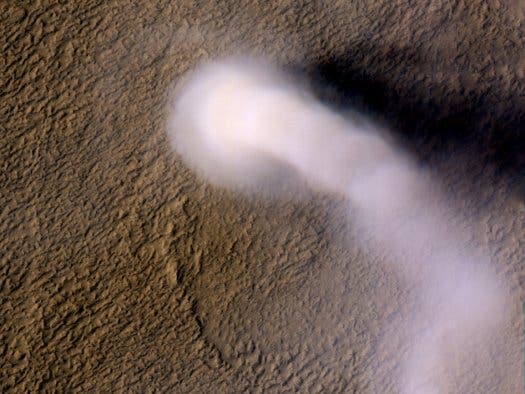
A massive whirling dust storm on the surface of Mars, as seen captured by the Mars Reconnaissance Orbiter. The extreme pressure swings experienced during a day-night cycle on the planet might drive the formation of such dust twisters. (c) NASA/JPL-Caltech/UA
Though a barren, life-intimidating landscape, Mars still has the most resembling weather to Earth compared to the other planets in our solar system. Recent measurements beamed by the Curiosity rover, which touched down on the martian surface a few weeks ago, have confirmed the scientists’ theories of extreme pressure swings. According to observations, pressure variations can be 100 times greater than those on Earth, and could potentially be the primary factor driving the massive dust storms on Mars.
Over the last 35 years, a total of four NASA probes have reached the Martian surface and returned weather data, however Curiosity is the only one to land in an “action center” – in the equator. Previous measurements have shown that the Martian atmosphere is subjected to significant temperature and pressure swings. The atmospheric temperature near the surface of Mars generally varies by more than 100 degrees Fahrenheit between day and night because of the overall thinner Martian atmosphere and lack of oceans and their moderating influence. However, this is the first time that such a huge pressure swing is encountered, although it was expected.
“The exciting new result from Curiosity is a regular and truly enormous swing in atmospheric pressure through each day. Measurements on Earth show a daily swing in pressure of only about one-tenth of 1 percent of the mean pressure, whereas Curiosity is measuring swings of almost 10 percent of the daily average pressure. We observe such a relative pressure change on Earth only with the passage of an extremely strong hurricane. At the Curiosity site on Mars, this enormous pressure swing occurs regularly every day,” said Kevin Hamilton, a pioneer in the area of computer modeling of the Martian atmosphere, and Director of UH Manoa’s International Pacific Research Center.
Hamilton theorized back in the 1980s, and later backed up his findings with a computer model, that particularly in two action centers on Mars, coupled with a resonance with the martian day-night cycle, that the pressure swings there should exceed 8 percent of the mean pressure. Pretty close to the actual measured data fed back by Curiosity.
According to Hamilton, these severe pressure variations could provide an answer to a mystery that has been puzzling scientists for quite some time now – how do the massive dust storms on the surface of the red planet form? Because of these pressure ‘mood’ swings, winds become sufficiently strong to lift enough dust from the surface to create the remarkable global dust storms seen every few years on that planet.









